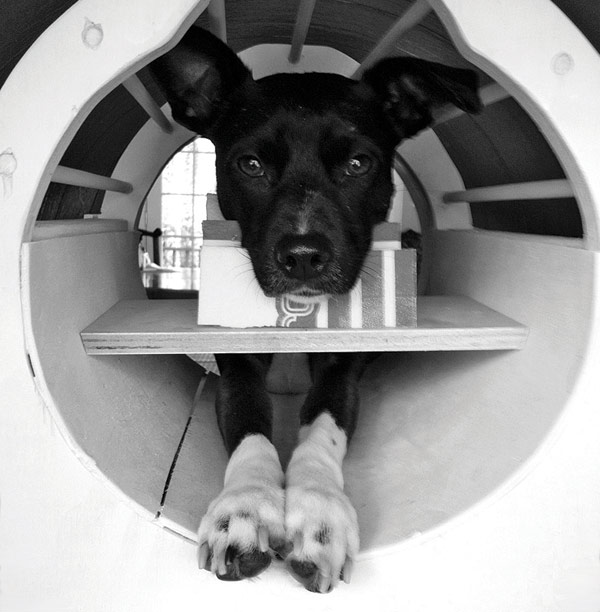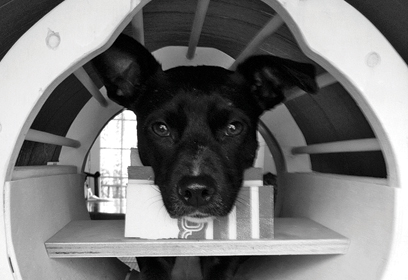 Callie, Gregory Berns’s dog and test subject, practices sitting still in a model MRI scanner. Photograph: Courtesy of New Harvest.
Callie, Gregory Berns’s dog and test subject, practices sitting still in a model MRI scanner. Photograph: Courtesy of New Harvest.
How Dogs Love Us
Gregory Berns
New Harvest, $25 (cloth)
Books abound on dog love, loving dogs, what it means to have or be with a dog. With all the writing about dogs, it might seem that we are too much infatuated with their unique qualities. But that is not it at all.
Even while we are ostensibly doing everything in our power to ascertain the nature and desires of dogs, the questions we ask obscure or betray what is most salient about them and necessary to their lives. And through it all—the testing and the loving, the ownership and the training, the argument for dog rights and the facts of their disposal—we never question the status of the human as a problem not a privilege.
To say, as Gregory Berns does in his new book How Dogs Love Us and his recent New York Times op-ed “Dogs are People, Too,” that dogs have the reasoning capacity of a young child is to continue to ignore what it is that dogs possess that we do not. Dogs are not people. Dogs are not humans. But we are desperate to appropriate whatever it means to be dog and to make that over in our image.
The urge to characterize dogs as like ourselves speaks to our ignorance and to the failure of imagination. As humans who control the arena of judgment, we cannot brook the humility demanded in confronting what we cannot understand, what we do not know.
We need to step back and ask how we can know feeling that is not tied to our assumptions. To risk losing ourselves in what is beyond our ken is to experience what it might mean to feel sufficiently. In other words, to know the kind of imaginative response that does not simply substitute one hierarchy for another but instead enables us to see otherwise or cross-wise. Perhaps animality is what we should be thinking about and not claims for humanity. Dogs live on the track between the mental and the physical and seem to tease out a near-mystical disintegration of the bounds between them. Their knowing has everything to do with perception, an unprecedented attentiveness that unleashes another kind of intelligibility beyond the world of the human.
What’s love got to do with it?
Those of us who live with dogs experience their peculiar sentience. It comes across as a full-hearted exuberance. Perhaps this is what the Puritan divine Jonathan Edwards meant when he emphasized a “physical” rather than “moral” conversion. He knew that the crux of divinity in earthbound entities lay in “the heart’s affections,” the great heart that very different kinds of writers about dogs insist upon.
But now whatever we mean by “heart”—which the poet, dog trainer, and philosopher Vicki Hearne and other dog trainers and breeders call “gameness,” not “love”—has become ominously repetitive, reduced to what Jeffrey Moussaieff Masson in Dogs Never Lie About Love (1997) identifies as their “master emotion”—“the dog is love . . . dogs are all about love.” Kathy Rudy in Loving Animals: Toward a New Animal Advocacy (2011) takes nonhuman animals, especially her dogs, as prompts for a meditation on a love so all-encompassing that it calls for “sacrifice on both parts.” That is inevitable because of our mutually affecting entanglement, yet the only sacrifice explicitly described in the book is that of the animals—not only dogs but chickens, pigs, and cows as well. As long as we love the animals we eat—or eat them lovingly—we can be sanguine about what she calls “animal advocacy.”
Can we define “love” better if we consider not our own emotions but what dogs think? It is easy to assume that dogs don’t think at all, that, because dogs live and act within the habitat of humans, we think for them. As Bern’s research demonstrates, that is wrong, but dogs are too tactful to let us know. So we delude ourselves into thinking that they are mere objects of sense, brute icons of the human that need to be coaxed into obedience, beguiled into submission.
The urge to characterize dogs as like ourselves speaks to our failure of imagination.
The trainer William Koehler called those who would objectify dogs in this way “humaniacs.” Hearne understood the dangers of these people and their tendency to coddle. As she never tired of saying, their rules for kindness reduce animals to recipients of charity, or worse, of their masters’ beneficence. She emphasized in her book Adam’s Task: Calling Animals By Name (1986) that humans have to earn the right to say, “sit”; and, as Koehler believed, “Dogs have responsibility for the consequences of their actions.” Training is intensely shared work. It must be done out of respect for and commitment to dogs’ intellectual capacities, not out of the determination to make dogs over in our image or, worse, to make them responsible for our “emotional well-being,” as Hearne put it.
She was right. Jon Katz’s A Good Dog (2006) is a best-selling book about how the border collie Orson saved Jon’s life and how Jon put Orson to death after the dog developed behavioral problems and bit three people. Katz writes about his struggles, his inconsistency and rage, his failure and grief. He chases Orson down the street, drags and throws him “about ten feet into some shrubs,” raging and yelling. After confessing to his readers, “I’d hurt Orson that morning, throwing him around like that,” Katz describes the “covenant” or “contract” he makes: “about faith and commitment about the love that I have always wanted and needed and which he seemed to need, too.”
For humans such as Katz and other popular writers, only dogs that have been humanized are worthy of living. Heart-warming experience matters. It ushers in an emotive ethics that has little to do with practical consequences. Formal training that creates work for both dogs and humans demands not the merging of self and dog that humanizers crave, but rather respect, restraint, and commitment. It also asks for a bit less drama. Discipline and a firm correction can save the lives of dogs, especially those that are overly aggressive. But such training, and the recognition of the dog’s active influence on it, offends those who have nothing to offer but their own emotions. Or it is condemned as cruel: exercising physical authority over a dog becomes the moral equivalent of fascism.
Once the word “love” is used, we think we know what matters to the dog, and the dog becomes nothing more than the measure of our emotional lives. In these relationships, if we can call them that, dogs are there to supply the conditions for a perpetual fascination with our own subjectivity. But when considering the deep feelings shared by humans and dogs, the reciprocal respect, attachment, and attentiveness, “love” is not the right word.
What humans make of dogs—and the numerous books that use dogs as prompts for better lives, deeper understanding, and self-congratulation—tells us something about the lethal care of humans. Nothing is more poignant than a story of great love that leads to murder. In her 2004 New Yorker essay “Dog Trouble,” Cathleen Schine tells of how she tried to tame Buster, “a seventeen-pound bowlegged mutt” whose adoption coincided with the break-up of her marriage, much as Katz acquired Orson at the onset of his midlife crisis. Unable to work with Buster and apparently unwilling to put him in the hands of a competent trainer, she kills the dog, the dog she loved, the dog that alienated her friends, threatened her son, and terrified her mother. We do not know right off that a dog is the subject: “He was volatile, unpredictable. But I felt responsible for him. And, against all odds, I loved him.”
Schine’s woes, fits, and obsessions are projected onto Buster. He chases his tail, he bites it, and he bites humans. Nowhere does she seem to understand that the dog is resolutely not human. Living in the space of confusion that is Schine’s home, Buster “refuses to be redeemed.” What does redemption mean to a dog? The “troubles” are not assuaged by assorted drugs and trainers. In one instance, Schine puts Buster in an Elizabethan collar—rather like a cone-shaped plastic bucket—and then leaves him locked up in a strange place. In a locale of such passionate inconsistency, the much sought-for “recovery” of Buster does not happen. The dog she calls “vicious” is guilty: guilty of not being human. After all, he “defies kindness, defies the culture of therapy.”
The ruses of sentiment fail to confront the alternately knowing and doubting relation that matters most between humans and dogs. In The Domestic Dog: Its Evolution, Behaviour, and Interactions with People (1995), James Serpell, unlike those who blur the difference between dogs and humans, considers what is unique about the dog’s position in human society. What makes domestic dogs special, he argues, is the paradox of our relation to them, the “surprising degree of ambivalence” they arouse in us, the way their “affinity with humans” incites “suspicion, denigration and hostility as well as devotion and respect.”
Dogs occupy that in-between place where opposites no longer hold, what Serpell calls “the no-man’s land between the human and non-human worlds.” They straddle the contradictions—body and spirit, persons and property, domestic and feral—so dear to us in our grid of value and insignificance. They threaten the categories and hierarchies that uphold our civilization and justify its worst excesses. Humans cannot stand much ambiguity. Perhaps that is why dogs are loved and loathed, coddled and killed.
Thinking dogs
Berns is a professor of neuroeconomics at Emory University. He has no truck with the use and abuse of monkeys at Yerkes National Primate Research Center, about a mile from his lab. He is also no behaviorist: he does not reject animal consciousness—and hence feeling, fear, and pain—altogether. He knows dogs are not “robots bumbling around the world, randomly doing things and finding out which behaviors result in food.” Nor is he guilty of the kinds of torturous treatment—for example, brain extraction—that made Yerkes infamous following the release in 1974 of Frederick Wiseman’s film Primate.
After decades spent using MRI technology to study the human brain, Berns decided to find out whether the same tools could be used to determine what dogs think. Insisting upon the dogs’ willingness, he even uses consent forms, signed by the dogs’ guardians, just as if they were children. “Wherever the words your child appeared, we replaced it with your dog,” he writes. It is clear everywhere in this book that Berns not only loves dogs but also respects them enough to demand that their participation in his project is voluntary. The dog can quit at any time. “Same as a human volunteer,” he assures us.
Berns’s goal matters to dogs and to humans. In the highly abnormal conditions of the MRI scanner—noise and constraint—Berns wants to prove that something that counts as “intelligence” is part of a dog’s everyday life. Callie, his black terrier mix (also known as a feist), is eager to be part of the experiment: standing ready for her head to be wrapped, ears muffed, she walks into the coil of the MRI scanner and puts her head on the chin rest. She learns to trot up the stairs into the magnet and assume “the sphinx position in the head coil.”
Treating dogs like children encourages us to disregard what is unique about them.
Berns turns to the neuroscientist Jaak Panskeep who advocates “mapping animal emotions onto corresponding brain systems that are common to all mammals.” This is where the real thrill in the research lies. Through the science of brain mapping, Berns finds amazing similarity between dogs and humans in both the structure and function of the brain region called the caudate nucleus, which is associated with positive emotions—“the expectation of something good”—and implicated in learning, memory, and the response to physical beauty.
Though the dogs at first work for hot dogs and peas, as the research continues, Berns realizes that more is going on. “Do dogs have some concept of humans as something more than food dispensers?” he asks.
Simply knowing that human feelings toward dogs are reciprocated in some way, even if only partially, changes everything. It would mean that dog-human relationships belong on the same plane as human-human relationships.
Dogs are thinking, feeling beings. We learn this not just because of the results of the brain scans, but also because Berns makes sure that we come to know his dogs and their lives outside of experimentation. These stories of trans-species sociality distinguish his book from others in the relatively new discipline of canine science. Callie pushes her way into Berns’s bed “almost always in a position uncomfortable for the human occupants,” leads him in hot pursuit of geese on the Chattahoochee River, and knows when the family’s other dog, Lyra, is dying.
Unlike some researchers who claim on one hand that animals are entitled to what they call “humane treatment” and on the other insist that ethics and ethical judgment have no place in science, Berns does not hesitate to glean ethical implications from his scientific practice. The stakes are clear: his brain scans show that dogs think and therefore are sentient persons. Consequently they should be granted rights of personhood. This is not so radical. Spain and New Zealand extend personhood rights to great apes. And in August the government of India ruled that cetaceans, such as whales and dolphins, should be regarded as “non-human persons” with their own specific rights.
But since no animal welfare act has yet “elevated the rights of dogs to the same level as those of our human subjects,” Berns’s goal is understandable. To say that dogs are persons is to attribute to them the kind of conscious intentionality that defines subjectivity as we understand it. “Never mind that all previous animal research treated animals as property,” Berns writes. “Elevating the rights of a dog to that of a human child made both ethical and scientific sense. It was the right thing to do and it would result in better-quality data too.”
More than Hot Dogs
Berns’s findings are compelling, but his conclusion, that dogs should have rights like those of human children, is troubling. Treating dogs like children demeans them and encourages us to disregard what is unique about their intelligence and character.
The problem begins with Berns’s training methods. In order to tempt dogs into the MRI scanner—no mean feat, I admit—Berns and his associates use positive reinforcement: they dispense pieces of hot dogs, sometimes with the sound of a clicker, with a frequency that makes me wonder about the weight gain of dogs not as active as Callie, who was among the study’s first subjects.
There is a contradiction here. Berns understands the social intelligence of dogs, and he knows how much it matters to do something “for social praise”—or what he calls “love”—rather than just for food. He distinguishes himself from B. F. Skinner and Ivan Pavlov, for he brings into the lab an appreciation and respect for dogs in what he calls “their native environment—the human household” where there is “give-and-take, and testing, on both sides.” So if he believes that dogs learn by observation and imitation, why does he still rely on hot dogs galore?
I think here of J. M. Coetzee, so obsessed was he in The Lives of Animals (1999) and Elizabeth Costello (2003) with the tragic diminution of the ape named Sultan. Sultan was reduced from a thinking being into one who did the least complicated or interesting task for nothing more than a quick treat. No matter what Berns finds in the dogs’ caudate nuclei, and no matter his good intentions in giving dogs the status of persons, the way to the result is littered with the bribery of treats. The characterization that remains in our minds is that of an entity with an insatiable appetite.
Does this matter? After all, he is after nothing less than what he calls “evidence for canine theory of mind.” More than that, he wants to prove dogs’ consciousness is on “the same level . . . as a young child,” so that they are protected against exploitation and cruelty. But we share with dogs a creaturely entanglement and mutual dependence that goes beyond infantilizing them as children. Dogs have a unique awareness, thoughts that matter, though they cannot be shared in our language.
The Problem of Animal Rights
At the edge of a cherished humanism, what if we summoned instead what Jean-Christophe Bailly calls “a kind of remote and uncertain reservoir on which all creatures might draw but from which most humans have learned to cut themselves off completely”? Instead of opposing humans to dogs, we need to question the boundaries of humanity, or, put more precisely, the making and management of human boundary objects. Why, to take up Mary Midgley’s argument in Animals and Why They Matter (1998), does “a sense of unreality” block “our attempts to understand our moral relations with animals”? Why is the question of the animal so hard to fit into our ethical system?
Beware animal rights talk: thousands of dogs are killed each year in the interest of rights.
Berns’s solution to this problem is rights. For him, the scans prove the reciprocity of human and canine “brain processes.” This means that dogs, too often disregarded, will be granted self-awareness. No longer property, they will have rights.
But we should beware of animal rights talk, of giving dogs what it is we think we get as bearers of rights and obligations in standard liberal and moral terms. What makes something an object of moral concern? Giving animals what we think they need or deserve in terms of human conceptions of right and wrong, or capacity or incapacity, is part of the top-down judgment that always fails those we speak for.
In Animals, Property, and the Law (1995), the legal scholar and activist Gary Francione warns about the calculated risks of rights talk. The word “rights” undergoes changes in meaning and reach depending on whom or what it applies to. Any consideration of how malleable legal language is in the law of slavery, prison law, or the rules and regulations of allowable suffering in animal experimentation proves his point: what is considered “‘humane’ treatment” or “‘unnecessary’ suffering may,” Francione explains, “differ considerably from the ordinary-language interpretation of those terms.”
Let us not forget that People for the Ethical Treatment of Animals (PETA) kills thousands of dogs every year, all in the interest of rights. In 2011 PETA took in 2,050 animals, mostly cats and dogs, and killed 1,965 of them. According to the logic governing the organization’s practices, the right of animals to be free of appropriation by humans justifies their deaths.
it is clear that there is another kind of relation experienced by human and dog, one that might matter differently and more than the recognition of rights—especially for those of us who want to continue living with dogs. “When Callie and I finally got home,” he writes, “we crashed together on the couch. We looked at each other once and then closed our eyes.” This is the interaction that matters, the two-way communication between dogs and humans, not our love that licenses the conferral of rights or death on its object.
So if dogs “love” us, what kind of love is it? Never afraid to ask tough questions, Berns takes us with him on his fascinating pursuit. If he stops short of giving dogs and humans equal purchase on emotions such as love and attachment—leaving dog sentience at the level of a child’s—he nevertheless proves that dogs and humans share physiological mechanisms and coexist not only on an emotional but also on a cognitive level. Dogs might even be our best teachers. “Could it be that our dogs tell us more about our human relationships than we tell ourselves?” he asks. Dogs know us and attend to our desires. The most we can do is inhabit the reciprocal possession, the responsibilities and ties, the mutuality of adaptation that Berns calls for with such candor and wonder.
At a time when some animal rights advocates argue for the extermination of dogs rather than have them suffer the indignity of being pets, I thank Berns for his wit and grace, for his courage in writing so that the contradictions of human and dog relationships remain intact, in all their wayward, messy, ambiguous, and paradoxical effects. Instead of attempting to define how and where we draw the line between humans and dogs, Berns helps us to understand—sometimes in spite of himself—how, where, and why human beings, often arbitrarily, devise, formulate, and apply lines separating the human and animal—or deliberately blur those lines.
Now let’s go further. We need to think again about dogs, as Berns suggests, but as the ground for human sensibility and cognition, not the other way around. In such a terrain, even the word “love” can be redeemed. And, perhaps, even the notion of “human.”








